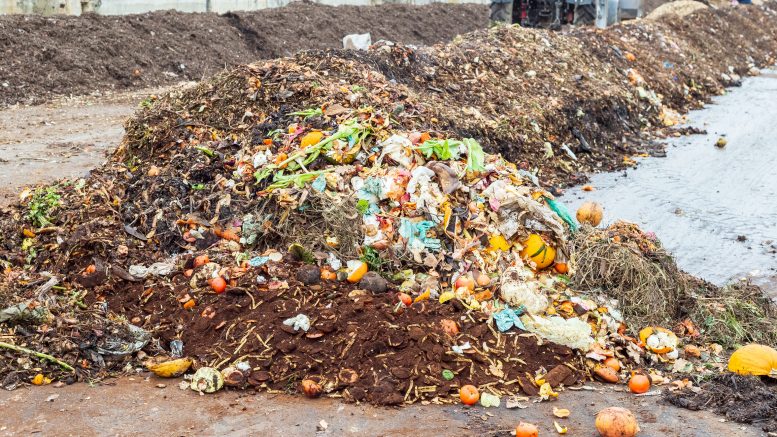Not all parts of California are the same, of course. There are heavily populated urban centers, rural areas, well-funded cities, small towns that struggle economically. So it’s no surprise that implementing a state mandate as complicated as the organic waste bill—SB 1383—is going to look different depending where we shine the light.
But instead of focusing solely on challenges, we thought it might be important to check out a city that is further down the road than some—with empirical successes and results—for a glimpse into what the future across the state could look like. We sat down with Valerie Osmond, deputy director of Integrated Waste Management in San Jose, to get her perspective.

In San Jose you’ve already had a lot of experience with diverting organic waste. What advice would you give to a city just starting to implement SB 1383?
In San Jose, we have the benefit of longstanding organics collection and processing programs.
In the commercial sector, we’ve been collecting organics such as food scraps and soiled paper products through source-separated ‘wet’ bins and sending the material to an anaerobic digestion facility, turning waste into energy and compost.
On the residential side of things, we have long collected clean and green yard trimmings primarily in piles loose in the street, though we also offer cart service. This has kept that organic material 99% free of contamination and makes for high-quality compost.
Over the course of several years, we phased in back-end processing of residential garbage, starting with multifamily homes in 2008 and then single-family homes in 2017. Residential garbage is sorted at a materials recovery facility and organics are removed and sent to become compost. These programs help us tremendously in our efforts to implement SB 1383. They have also helped by ensuring organics processing capacity, which is significant for a city the size of San Jose.
The city’s forward thinking with organics processing in residential and commercial programs helped meet the collection and processing requirements of SB 1383 without changes to existing programs. San Jose has been open to new and innovative technologies that led us to help develop the largest anaerobic digestion facility in the country in 2012. Our commitment to zero-waste has encouraged infrastructure development in the Bay Area.
For cities looking into different ways to implement SB 1383, I recommend exploring ideas that work for your community and your budget. Involving your council members and residents in such discussions early is vital to getting buy-in and being successful. Talk to CalRecycle early and often. There are different ways to get to your goal. Research what other cities are doing, be innovative, and do pilots! San Jose conducted a pilot in 2010, collecting separated organics at the curb. Participation was low and inconsistent. This pilot helped to inform our decision to start back-end sorting, which ensures ALL residents participate in composting.
Can you talk about some of your food recovery programs?
San Jose has had food distribution and meal programs for residents for a long time now. Organizations like Second Harvest Food Bank and Loaves & Fishes have been providing services to the food-insecure in the Bay Area and San Jose for many years. Now, the regulation requires enforcement, reporting, and many other obligations.
“For cities looking into different ways to implement SB 1383, I recommend exploring ideas that work for your community and your budget. Involving your council members and residents in such discussions early is vital to getting buy-in and being successful. Talk to CalRecycle early and often. … Research what other cities are doing, be innovative, and do pilots!”
Valerie Osmond, deputy director of Integrated Waste Management in San Jose
Implementation amid a pandemic has been challenging, but our experience in supporting the County of Santa Clara with food distribution during shelter-in-place also provides significant data and information. Struggling to identify resources, we found solutions in banding together with Santa Clara County cities and forming a regional program. We ensured we played a significant role in developing the program, since San Jose has more than half the food waste generators and residents in the county.
The program includes stakeholders like food recovery organizations and services that help understand and work through their challenges. Since food recovery and distribution is managed for the whole region, it makes more sense to also have a regional approach to enforcement, rather than having individual cities enforce. This approach helps combine efforts and unite messages across Santa Clara County. The county engaged a consultant to set up the program and we continue to work together to meet the requirements of the regulation.
What other tips do you have in terms of a successful program, such as a recycling cart lid replacement?
In the fall of 2020, San Jose conducted a single-family residential curbside study to measure recycling contamination. While contractually obligated to conduct this study during that time frame, it was unfortunate timing. Most people were still working and schooling from home and residential garbage and recycling tonnage was high.
As a result, recycling contamination was high, with a citywide average of 51%. In the spring of 2021, we conducted a recycling cart lid pilot, replacing about 5,000 recycling cart lids on carefully selected routes with new lids. The new lids had in-mold, full-color graphics, clearly depicting what should and should not go in the recycling cart. The limited text was in three languages. Following lid replacement, we conducted another study to measure recycling contamination on those same routes and found a 20% decrease in contamination. While these results are positive, swapping out lids is costly. These new lids meet SB 1383 labeling requirements, so some SB 1383 grant funding will be dedicated to replacing more lids, starting with our more highly contaminated routes. In addition to reducing contamination, this should also help get more organics into the garbage stream where it can be captured and composted.
What challenges are you still facing with implementing SB 1383?
SB 1383 is an unfunded and multifaceted mandate. Like other jurisdictions, we are struggling with resources to implement all the requirements. We have been operating with existing staff to work on implementation and utilizing existing funding sources. Although we don’t have to change our collection and processing systems, there are other parts of the regulations that we are still finding ways to best include or add to our city functions.
Here are a couple examples.
There are extensive reporting and record-keeping requirements in the regulation that apply to all city departments. Since we are a big city, we are continuing efforts to find the most productive and cost-effective ways to collaborate on identifying and managing the data. This is different for our waste management team, since now the data needs to come from many different departments that are out of our purview.
Another major challenge is measuring and meeting SB 1383 procurement targets. San Jose is the third-largest city in California, with more than one million residents. Our procurement target is very high, at more than 82,000 tons. Being a large city with many capital improvement projects, landscape maintenance contracts, and all types of properties under various city departments, capturing and understanding what we are already procuring is a significant undertaking.
The current usage of SB 1383 qualifying products by the city and their contractors is unknown, since we were not required to track such information until now. This is a big shift for some teams in the city, because they have long-term contracts and the requirements are already set. Also, we don’t have a clear understanding of market impacts due to these requirements that all jurisdictions are required to follow. So, we need to understand how this impacts our budget and how to fill any gaps. We take the use of public funds very seriously and do not intend to buy things we don’t need. It is likely that we will need to revisit our procurement targets in the future.
Just for fun, ice cream, cake or pie? Dog or cat person? Beach or mountains?
Ice cream, all day, every day. / Cats! But I love dogs, too. / Yes! Ideally, a beach at a mountain lake.






Be the first to comment on "San Jose is a model of how collecting organic waste may look across California—even though challenges remain."